大数据介绍英文方案
大数据 英语作文
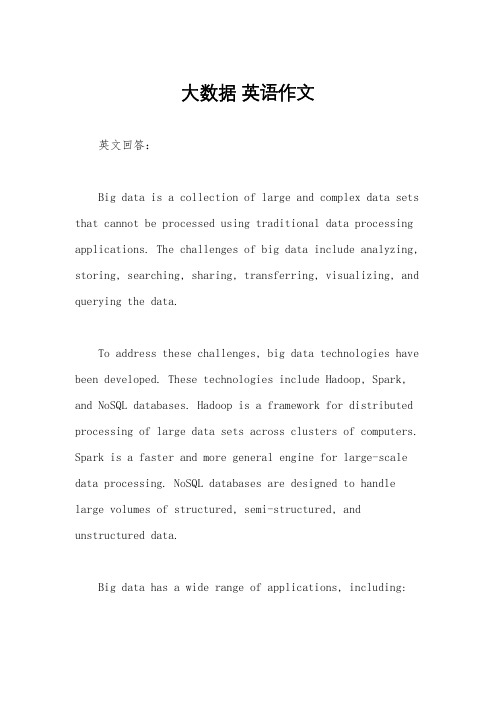
大数据英语作文英文回答:Big data is a collection of large and complex data sets that cannot be processed using traditional data processing applications. The challenges of big data include analyzing, storing, searching, sharing, transferring, visualizing, and querying the data.To address these challenges, big data technologies have been developed. These technologies include Hadoop, Spark, and NoSQL databases. Hadoop is a framework for distributed processing of large data sets across clusters of computers. Spark is a faster and more general engine for large-scale data processing. NoSQL databases are designed to handle large volumes of structured, semi-structured, and unstructured data.Big data has a wide range of applications, including:Fraud detection: Big data can be used to identify fraudulent transactions by analyzing large volumes of data, such as transaction logs and customer profiles.Customer segmentation: Big data can be used to segment customers into different groups based on their demographics, behavior, and preferences. This information can be used to target marketing campaigns and improve customer service.Predictive analytics: Big data can be used to predict future events, such as customer churn and product demand. This information can be used to make better decisions about product development, marketing, and customer service.Big data is a powerful tool that can be used to improve decision-making, increase efficiency, and reduce costs. As the volume and variety of data continues to grow, big data technologies will become increasingly important.中文回答:大数据是指无法使用传统数据处理应用程序处理的海量且复杂的数据集。
大数据英文发言稿模板范文
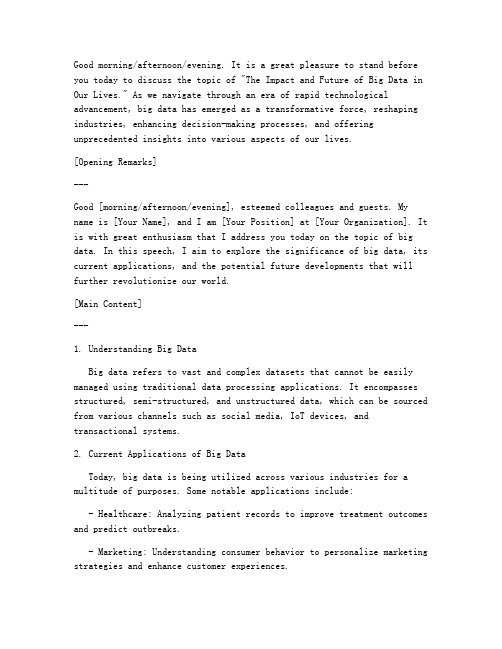
Good morning/afternoon/evening. It is a great pleasure to stand before you today to discuss the topic of "The Impact and Future of Big Data in Our Lives." As we navigate through an era of rapid technological advancement, big data has emerged as a transformative force, reshaping industries, enhancing decision-making processes, and offering unprecedented insights into various aspects of our lives.[Opening Remarks]---Good [morning/afternoon/evening], esteemed colleagues and guests. My name is [Your Name], and I am [Your Position] at [Your Organization]. It is with great enthusiasm that I address you today on the topic of big data. In this speech, I aim to explore the significance of big data, its current applications, and the potential future developments that will further revolutionize our world.[Main Content]---1. Understanding Big DataBig data refers to vast and complex datasets that cannot be easily managed using traditional data processing applications. It encompasses structured, semi-structured, and unstructured data, which can be sourced from various channels such as social media, IoT devices, and transactional systems.2. Current Applications of Big DataToday, big data is being utilized across various industries for a multitude of purposes. Some notable applications include:- Healthcare: Analyzing patient records to improve treatment outcomes and predict outbreaks.- Marketing: Understanding consumer behavior to personalize marketing strategies and enhance customer experiences.- Finance: Monitoring transactions for fraud detection and optimizing risk management.- Education: Personalizing learning experiences and improving educational outcomes through data-driven insights.3. The Potential of Big DataThe potential of big data is vast, and it is only scratching the surface of what it can achieve. Here are a few future developments wecan expect:- Predictive Analytics: Leveraging machine learning algorithms to predict future trends and outcomes with greater accuracy.- Real-time Decision Making: Enabling businesses and organizations to make informed decisions in real-time, based on up-to-date data.- Autonomous Systems: Enhancing the capabilities of autonomous vehicles, drones, and other systems through real-time data processingand analysis.[Closing Remarks]---As we move forward, it is crucial to recognize the ethical implications and challenges associated with big data. Privacy concerns, data security, and the potential for misuse are all important considerations that need to be addressed. However, with responsible stewardship and proper regulations, big data has the potential to bring about significant advancements and improvements in our lives.In conclusion, big data is a powerful tool that has the capacity to transform industries, societies, and our understanding of the world. By harnessing its potential responsibly, we can create a brighter and more connected future for all.[Call to Action]---I encourage each of you to embrace the opportunities that big data presents and to consider how you can contribute to its development and application in a positive and ethical manner. Let us work together to harness the power of big data to make our world a better place.Thank you for your attention, and I welcome any questions you may have.[End of Speech]---Please note that this is a template and should be customized according to your specific context, organization, and the audience you are addressing.。
大数据的影响英文介绍作文

大数据的影响英文介绍作文Title: The Impact of Big Data: Revolutionizing the Future。
In the digital age, the advent of big data has usheredin a new era of innovation and transformation acrossvarious sectors. Big data, characterized by its vast volume, high velocity, and diverse variety, has profoundlyinfluenced numerous aspects of our lives, ranging from business and healthcare to education and governance. This essay delves into the multifaceted impact of big data, exploring its implications and opportunities for the future.One of the most significant effects of big data lies in its capacity to revolutionize decision-making processes. Through advanced analytics and predictive modeling, bigdata enables organizations to derive actionable insights from massive datasets in real-time. By leveraging these insights, businesses can make informed strategic decisions, optimize operations, and gain a competitive edge in themarket. For instance, retailers can analyze customer purchasing patterns to personalize marketing campaigns, leading to higher customer engagement and increased sales revenue.Furthermore, big data plays a crucial role in driving innovation and fostering technological advancements. The wealth of data generated from various sources, including social media, sensors, and online transactions, serves as a valuable resource for research and development. Machine learning algorithms and artificial intelligence algorithms can analyze this data to uncover hidden patterns,facilitate product innovation, and fuel the creation of disruptive technologies. For example, in the healthcare sector, big data analytics is instrumental in drug discovery, disease diagnosis, and personalized medicine, leading to improved patient outcomes and enhanced healthcare delivery.Moreover, big data has transformative implications for society as a whole, particularly in the realm of governance and public policy. Government agencies can harness big dataanalytics to enhance decision-making processes, improve service delivery, and address societal challenges more effectively. By analyzing data related to transportation, urban planning, and public health, policymakers can develop evidence-based policies and interventions that better meet the needs of citizens. Additionally, big data enables greater transparency and accountability in governance by providing insights into government operations and expenditures, thereby fostering public trust and participation in democratic processes.However, alongside its myriad benefits, big data also raises important ethical, privacy, and security concerns. The collection and analysis of vast amounts of personal data raise questions about individual privacy rights and data protection. Moreover, the potential for data breaches and cyberattacks poses significant risks to data security and confidentiality. As such, it is imperative for organizations and policymakers to implement robust data governance frameworks, security measures, and ethical guidelines to safeguard against misuse and abuse of data.In conclusion, big data represents a transformative force that is reshaping the way we live, work, and interact with the world around us. From enabling data-driven decision-making and fostering innovation to enhancing governance and public policy, the impact of big data is profound and far-reaching. However, realizing the full potential of big data requires a concerted effort to address ethical, privacy, and security concerns, ensuring that its benefits are equitably distributed and responsibly managed. As we continue to harness the power of big data, we have the opportunity to unlock new possibilities and create a more prosperous and sustainable future for generations to come.。
大数据技术与工程英文介绍范文
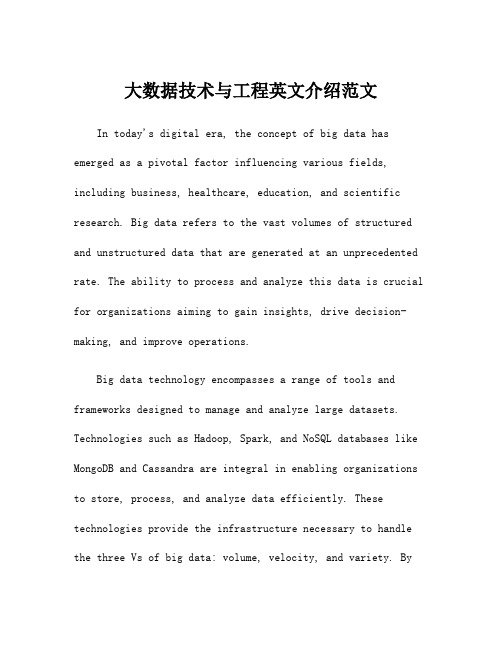
大数据技术与工程英文介绍范文In today's digital era, the concept of big data has emerged as a pivotal factor influencing various fields, including business, healthcare, education, and scientific research. Big data refers to the vast volumes of structured and unstructured data that are generated at an unprecedented rate. The ability to process and analyze this data is crucial for organizations aiming to gain insights, drive decision-making, and improve operations.Big data technology encompasses a range of tools and frameworks designed to manage and analyze large datasets. Technologies such as Hadoop, Spark, and NoSQL databases like MongoDB and Cassandra are integral in enabling organizations to store, process, and analyze data efficiently. These technologies provide the infrastructure necessary to handle the three Vs of big data: volume, velocity, and variety. Byleveraging distributed computing and storage, big data technologies allow organizations to scale their data processing capabilities while reducing costs.Moreover, big data engineering is concerned with the creation of architectures and systems that facilitate the processing of data. This includes the design and implementation of data pipelines, data lakes, and data warehouses. Data engineers play a vital role in ensuring that data is collected, processed, and made accessible for analytical purposes. Their expertise in programming, database management, and data modeling is essential for developing solutions that meet the specific needs of an organization.The application of big data analysis is vast and varied. For instance, in healthcare, it helps in predicting disease outbreaks, personalizing treatment plans, and optimizing operational efficiency. In retail, businesses can analyze consumer behavior to enhance customer experiences and drivesales. Furthermore, in the realm of finance, big data analytics detects fraud and assesses risk in real-time.In conclusion, the intersection of big data technology and engineering is transforming the way organizations operate and make decisions. By harnessing the power of big data, businesses can unlock valuable insights that drive innovation and improve their competitive edge in the market. As we continue to generate more data, understanding and implementing effective big data solutions will become increasingly important for future advancements across all sectors.。
大数据运营方案及步骤英文

大数据运营方案及步骤英文Introduction:In today's data-driven world, companies are leveraging big data to gain insights, make informed decisions, and optimize their operations. A robust big data operation plan is crucial for harnessing the power of data and driving business success. This article presents a comprehensive big data operation plan with detailed steps to help businesses effectively manage big data and gain a competitive edge.I. Defining the Objectives:1. Assess business goals and identify specific objectives for the big data operation plan.2. Define key performance indicators (KPIs) and metrics to measure the success of the plan.3. Align objectives with the overall business strategy and ensure they are realistic and achievable.II. Data Collection and Integration:1. Identify the data sources required for analysis, including internal and external sources.2. Determine the data collection methods and tools needed to extract and integrate data.3. Establish data governance policies, including data quality standards, security protocols, and compliance guidelines.4. Set up data warehousing and data lakes for storage and processing of the collected data. III. Data Cleaning and Preprocessing:1. Conduct data cleaning to identify and correct errors, inconsistencies, and missing values.2. Remove duplicate or irrelevant data to improve the accuracy and reliability of analysis.3. Normalize and standardize data to make it consistent and compatible for further analysis.4. Apply data anonymization techniques to protect sensitive information.IV. Exploratory Data Analysis:1. Perform descriptive statistics and visualization techniques to gain initial insights into the data.2. Identify patterns, trends, and outliers that may require further investigation.3. Conduct correlation and regression analyses to determine relationships between variables.4. Use clustering and classification algorithms to group similar data points and make predictions.V. Advanced Analytics:1. Apply machine learning algorithms for predictive modeling and forecasting.2. Utilize natural language processing (NLP) techniques for sentiment analysis and text mining.3. Implement recommendation systems to personalize customer experiences and drive sales.4. Employ time series analysis to forecast demand, optimize inventory, and improve resource allocation.VI. Data Visualization and Reporting:1. Create interactive dashboards and visualization tools to present analysis findings.2. Generate regular reports and share them with relevant stakeholders.3. Customize visualizations based on specific user requirements and preferences.4. Incorporate storytelling techniques to effectively communicate insights and facilitate decision-making.VII. Continual Monitoring and Optimization:1. Establish a monitoring system to track the performance of the big data operation plan.2. Identify areas of improvement and implement corrective actions as needed.3. Continuously update and refine the data operation plan based on new requirements and emerging technologies.4. Foster a culture of data-driven decision-making and encourage feedback from users and stakeholders.Conclusion:A well-executed big data operation plan provides businesses with a competitive advantage by enabling them to make data-driven decisions, improve customer experiences, and drive innovation. By following the steps outlined in this article, organizations can effectively manage big data, extract valuable insights, and stay ahead in the dynamic world of data analytics.。
大数据文献综述英文版
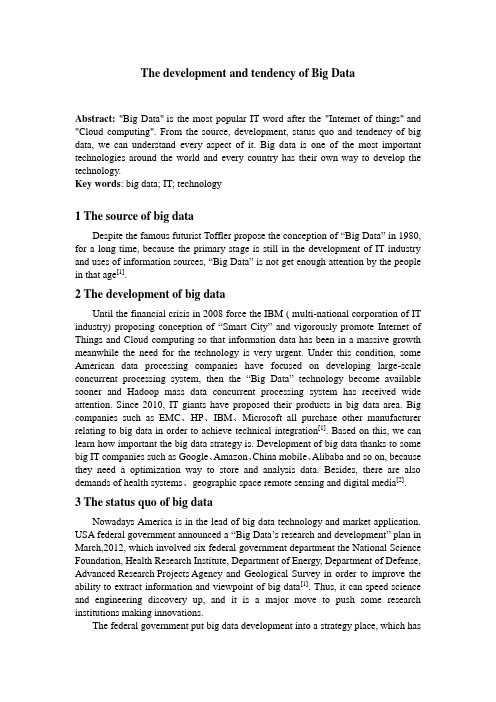
The development and tendency of Big DataAbstract: "Big Data" is the most popular IT word after the "Internet of things" and "Cloud computing". From the source, development, status quo and tendency of big data, we can understand every aspect of it. Big data is one of the most important technologies around the world and every country has their own way to develop the technology.Key words: big data; IT; technology1 The source of big dataDespite the famous futurist Toffler propose the conception of “Big Data” in 1980, for a long time, because the primary stage is still in the development of IT industry and uses of information sources, “Big Data” is not get enough attention by the people in that age[1].2 The development of big dataUntil the financial crisis in 2008 force the IBM ( multi-national corporation of IT industry) proposing conception of “Smart City”and vigorously promote Internet of Things and Cloud computing so that information data has been in a massive growth meanwhile the need for the technology is very urgent. Under this condition, some American data processing companies have focused on developing large-scale concurrent processing system, then the “Big Data”technology become available sooner and Hadoop mass data concurrent processing system has received wide attention. Since 2010, IT giants have proposed their products in big data area. Big companies such as EMC、HP、IBM、Microsoft all purchase other manufacturer relating to big data in order to achieve technical integration[1]. Based on this, we can learn how important the big data strategy is. Development of big data thanks to some big IT companies such as Google、Amazon、China mobile、Alibaba and so on, because they need a optimization way to store and analysis data. Besides, there are also demands of health systems、geographic space remote sensing and digital media[2].3 The status quo of big dataNowadays America is in the lead of big data technology and market application. USA federal government announced a “Big Data’s research and development” plan in March,2012, which involved six federal government department the National Science Foundation, Health Research Institute, Department of Energy, Department of Defense, Advanced Research Projects Agency and Geological Survey in order to improve the ability to extract information and viewpoint of big data[1]. Thus, it can speed science and engineering discovery up, and it is a major move to push some research institutions making innovations.The federal government put big data development into a strategy place, which hasa big impact on every country. At present, many big European institutions is still at the primary stage to use big data and seriously lack technology about big data. Most improvements and technology of big data are come from America. Therefore, there are kind of challenges of Europe to keep in step with the development of big data. But, in the financial service industry especially investment banking in London is one of the earliest industries in Europe. The experiment and technology of big data is as good as the giant institution of America. And, the investment of big data has been maintained promising efforts. January 2013, British government announced 1.89 million pound will be invested in big data and calculation of energy saving technology in earth observation and health care[3].Japanese government timely takes the challenge of big data strategy. July 2013, Japan’s communications ministry proposed a synthesize strategy called “Energy ICT of Japan” which focused on big data application. June 2013, the abe cabinet formally announced the new IT strategy----“The announcement of creating the most advanced IT country”. This announcement comprehensively expounded that Japanese new IT national strategy is with the core of developing opening public data and big data in 2013 to 2020[4].Big data has also drawn attention of China government.《Guiding opinions of the State Council on promoting the healthy and orderly development of the Internet of things》promote to quicken the core technology including sensor network、intelligent terminal、big data processing、intelligent analysis and service integration. December 2012, the national development and reform commission add data analysis software into special guide, in the beginning of 2013 ministry of science and technology announced that big data research is one of the most important content of “973 program”[1]. This program requests that we need to research the expression, measure and semantic understanding of multi-source heterogeneous data, research modeling theory and computational model, promote hardware and software system architecture by energy optimal distributed storage and processing, analysis the relationship of complexity、calculability and treatment efficiency[1]. Above all, we can provide theory evidence for setting up scientific system of big data.4 The tendency of big data4.1 See the future by big dataIn the beginning of 2008, Alibaba found that the whole number of sellers were on a slippery slope by mining analyzing user-behavior data meanwhile the procurement to Europe and America was also glide. They accurately predicting the trend of world economic trade unfold half year earlier so they avoid the financial crisis[2]. Document [3] cite an example which turned out can predict a cholera one year earlier by mining and analysis the data of storm, drought and other natural disaster[3].4.2 Great changes and business opportunitiesWith the approval of big data values, giants of every industry all spend more money in big data industry. Then great changes and business opportunity comes[4].In hardware industry, big data are facing the challenges of manage, storage and real-time analysis. Big data will have an important impact of chip and storage industry,besides, some new industry will be created because of big data[4].In software and service area, the urgent demand of fast data processing will bring great boom to data mining and business intelligence industry.The hidden value of big data can create a lot of new companies, new products, new technology and new projects[2].4.3 Development direction of big dataThe storage technology of big data is relational database at primary. But due to the canonical design, friendly query language, efficient ability dealing with online affair, Big data dominate the market a long term. However, its strict design pattern, it ensures consistency to give up function, its poor expansibility these problems are exposed in big data analysis. Then, NoSQL data storage model and Bigtable propsed by Google start to be in fashion[5].Big data analysis technology which uses MapReduce technological frame proposed by Google is used to deal with large scale concurrent batch transaction. Using file system to store unstructured data is not lost function but also win the expansilility. Later, there are big data analysis platform like HA VEn proposed by HP and Fusion Insight proposed by Huawei . Beyond doubt, this situation will be continued, new technology and measures will come out such as next generation data warehouse, Hadoop distribute and so on[6].ConclusionThis paper we analysis the development and tendency of big data. Based on this, we know that the big data is still at a primary stage, there are too many problems need to deal with. But the commercial value and market value of big data are the direction of development to information age.忽略此处..[1] Li Chunwei, Development report of China’s E-Commerce enterprises, Beijing , 2013,pp.268-270[2] Li Fen, Zhu Zhixiang, Liu Shenghui, The development status and the problems of large data, Journal of Xi’an University of Posts and Telecommunications, 18 volume, pp. 102-103,sep.2013 [3] Kira Radinsky, Eric Horivtz, Mining the Web to Predict Future Events[C]//Proceedings of the 6th ACM International Conference on Web Search and Data Mining, WSDM 2013: New York: Association for Computing Machinery,2013,pp.255-264[4] Chapman A, Allen M D, Blaustein B. It’s About the Data: Provenance as a Toll for Assessing Data Fitness[C]//Proc of the 4th USENIX Workshop on the Theory and Practice of Provenance, Berkely, CA: USENIX Association, 2012:8[5] Li Ruiqin, Zheng Janguo, Big data Research: Status quo, Problems and Tendency[J],Network Application,Shanghai,1994,pp.107-108[6] Meng Xiaofeng, Wang Huiju, Du Xiaoyong, Big Daya Analysis: Competition and Survival of RDBMS and ManReduce[J], Journal of software, 2012,23(1): 32-45。
大数据英文版介绍

Dynamo
Amazon
HBase
Open source
Open source Open source
The Column-oriented database is built on HDFS, which supports executing of MapReduce tasks and Java API
Database Management - NoSQL
DBMS based on NoSQL
BigTable
Authorizerhe database engine based on GFS, which includes set of key-value pairs that are of sparsity, distribution, durability and multi dimension Provides a tightly handle over tradeoffs between consistency, availability and extendibility and the technology of consistent hashing
Environment of execution tools
The key aspect of the MapReduce algorithm is that if every Map and Reduce is independent of all other ongoing Maps and Reduces, then the operation can be run in parallel on different keys and lists of data. On a large cluster of machines, you can go one step further, and run the Map operations on servers where the data lives. Rather than copy the data over the network to the program, you push out the program to the machines. The output list can then be saved to the distributed filesystem, and the reducers run to merge the results.
大数据英文版简版
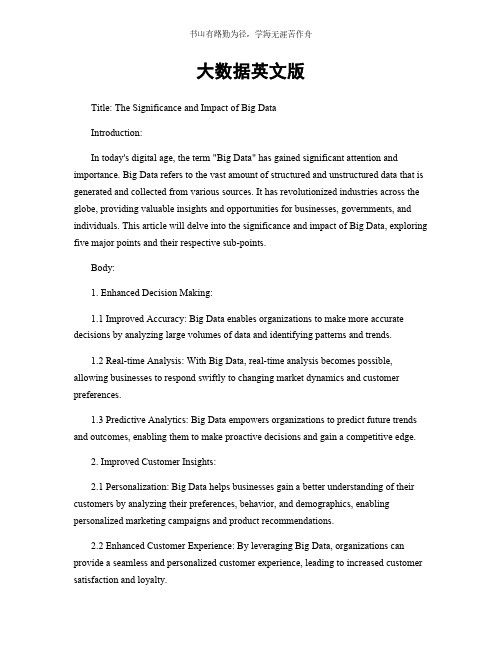
大数据英文版Title: The Significance and Impact of Big DataIntroduction:In today's digital age, the term "Big Data" has gained significant attention and importance. Big Data refers to the vast amount of structured and unstructured data that is generated and collected from various sources. It has revolutionized industries across the globe, providing valuable insights and opportunities for businesses, governments, and individuals. This article will delve into the significance and impact of Big Data, exploring five major points and their respective sub-points.Body:1. Enhanced Decision Making:1.1 Improved Accuracy: Big Data enables organizations to make more accurate decisions by analyzing large volumes of data and identifying patterns and trends.1.2 Real-time Analysis: With Big Data, real-time analysis becomes possible, allowing businesses to respond swiftly to changing market dynamics and customer preferences.1.3 Predictive Analytics: Big Data empowers organizations to predict future trends and outcomes, enabling them to make proactive decisions and gain a competitive edge.2. Improved Customer Insights:2.1 Personalization: Big Data helps businesses gain a better understanding of their customers by analyzing their preferences, behavior, and demographics, enabling personalized marketing campaigns and product recommendations.2.2 Enhanced Customer Experience: By leveraging Big Data, organizations can provide a seamless and personalized customer experience, leading to increased customer satisfaction and loyalty.2.3 Targeted Marketing: Big Data enables businesses to target specific customer segments more effectively, resulting in higher conversion rates and improved marketing ROI.3. Cost Reduction and Efficiency:3.1 Operational Efficiency: Big Data analytics helps identify inefficiencies in business processes, enabling organizations to streamline operations and reduce costs.3.2 Resource Optimization: By analyzing data, businesses can optimize resource allocation, minimizing waste and improving overall efficiency.3.3 Fraud Detection: Big Data analytics plays a crucial role in detecting fraudulent activities, reducing financial losses, and enhancing security measures.4. Innovation and New Opportunities:4.1 Product Development: Big Data provides valuable insights into customer needs and preferences, facilitating the development of innovative products and services.4.2 Market Expansion: By analyzing Big Data, organizations can identify new market opportunities and expand their customer base.4.3 Competitive Advantage: Big Data enables businesses to gain a competitive advantage by uncovering market trends, consumer sentiments, and competitor strategies.5. Healthcare and Scientific Advancements:5.1 Disease Prevention and Treatment: Big Data analytics helps identify disease patterns, predict outbreaks, and develop effective prevention and treatment strategies.5.2 Drug Discovery: Big Data plays a vital role in accelerating drug discovery processes by analyzing vast amounts of genetic and clinical data.5.3 Precision Medicine: By analyzing individual patient data, Big Data facilitates personalized treatment plans, improving patient outcomes and reducing healthcare costs.Conclusion:In conclusion, Big Data has emerged as a game-changer in various industries, revolutionizing decision-making processes, customer insights, cost reduction, innovation, and advancements in healthcare and science. Its significance and impact are undeniable, providing organizations with valuable opportunities to gain a competitive edge, improve efficiency, and drive growth. As we continue to generate and collect massive amounts of data, harnessing the power of Big Data will remain crucial for success in the digital era.。
- 1、下载文档前请自行甄别文档内容的完整性,平台不提供额外的编辑、内容补充、找答案等附加服务。
- 2、"仅部分预览"的文档,不可在线预览部分如存在完整性等问题,可反馈申请退款(可完整预览的文档不适用该条件!)。
- 3、如文档侵犯您的权益,请联系客服反馈,我们会尽快为您处理(人工客服工作时间:9:00-18:30)。
EVERY MINUTE…
Didi rides hailed:
1,388
cabs
2,777
private cars
EVERY MINUTE…
395,833 People log in To WeChat
194,444 people are video or audio chatting
on Alibaba’s marketplaces
US$1,133,942
spent on Alibaba
1 2
Definition
Characteristic NoSQL RDBMS MapReduce Applications
C
3ቤተ መጻሕፍቲ ባይዱ
ONTENTS 4 5
6
1
Definition
1 Definition
EVERY MINUTE…
625,000
Youku Tudou videos being watched
EVERY MINUTE…
64,814
posts and reposts on Weibo
4,166,667 search queries
SEARCH
EVERY MINUTE…
774 people buy something
Variety
The type and nature of the data.
Velocity
In this context, the speed at which the data is generated and processed to meet the demands and challenges that lie in the path of growth and development.
3
NoSQL
3 NoSQL
NoSQL refers to document-oriented databases SQL doesn’t scale well horizontally. It is schemaless. But not formless (JSON format). JSON: data interchange format Mongo Database Couch Database
Eventual Consistency
at some point in the future, data will converge to a consistent state. No guarantees are made “when”.
3 NoSQL
JSON Structure
{ field1: value1, field2: value2 … fieldN: valueN } var mydoc = { _id:ObjectId("5099803df3f4948bd2f98391"), name: { first: "Alan", last: "Turing" }, birth: new Date('Jun 23, 1912'), death: new Date('Jun 07, 1954'), contribs: [ "Turing machine", "Turing test", …], views : NumberLong(1250000) }
3 NoSQL
RDBMS vs NoSQL
• Xszc
Row DB: 001:10,Smith,Joe,40000;002:12,Jones,Mary,50000;003:11,Johnson,Cathy,44000;004:22,Jones,Bob,5 5000; index: 001:40000;002:50000;003:44000;004:55000; Column DB: 10:001,12:002,11:003,22:004;Smith:001,Jones:002,Johnson:003,Jones:004;Joe:001,Mary:002,Cathy: 003,Bob:004;40000:001,50000 …;Smith:001,Jones:002,004,Johnson:003;…
3 NoSQL
Benefits
• Column-oriented organizations are more efficient when an aggregate needs to be computed over many rows but only for a notably smaller subset of all columns of data, because reading that smaller subset of data can be faster than reading all data. • Column-oriented organizations are more efficient when new values of a column are supplied for all rows at once, because that column data can be written efficiently and replace old column data without touching any other columns for the rows. • Row-oriented organizations are more efficient when many columns of a single row are required at the same time, and when row-size is relatively small, as the entire row can be retrieved with a single disk seek. • Row-oriented organizations are more efficient when writing a new row if all of the column data is supplied at the same time, as the entire row can be written with a single disk seek.
3 NoSQL
Basic Availability
spread data across many storage systems with a high degree of replication.
Base Model
Soft State
data consistency is the developer's problem and should not be handled by the database.
on a day-to-day basis
volume of data
BIG DATA
for better decisions
important data
2
Characteristic
2 Characteristic
Volume
The quantity of generated and stored data.
Variability
Inconsistency of the data set can hamper processes to handle and manage it.
Veracity
The quality of captured data can vary greatly, affecting accurate analysis.
